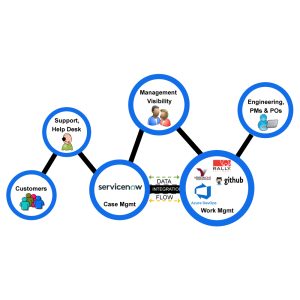In the evolving world of today companies are always looking for ways to boost their performance, streamline operations and foster creativity. IBM Cloud Integration has emerged as a resource to address these requirements. This article delves into the benefits of IBM Cloud Integration, in delivering business advantages offering real world tips and effective approaches, to making the most of this technology.
Exploring IBM Cloud Integration
IBM Cloud Integration consists of a range of tools and services aimed at assisting businesses in linking applications, data and processes across environments. Whether you’re managing, on premises systems, private clouds or public clouds IBM Cloud Integration offers an approach to ensure interoperability.
This platform offers integration options, such as managing APIs, integrating applications, merging data, exchanging messages and streaming events. By utilizing these functions companies can enhance their efficiency and flexibility. IBM Cloud Integration also includes security measures to safeguard data both in transit and at rest.
Moreover it facilitates compliance with industry regulations and standards simplifying the fulfillment of requirements, for businesses. With its expandable structure IBM Cloud Integration can expand alongside your company adjusting to evolving needs and assisting you in maintaining competitiveness in a changing market.
Key Components of IBM Cloud Integration
- API Management: Facilitates the development, administration and secure exposure of APIs to facilitate communication between software components.
- Application Integration: Links applications together to ensure data flow across systems.
- Data Integration: Combines data from sources to provide a perspective for improved decision making.
- Messaging: Guarantees secure message exchange between applications.
- Event Streaming: Captures and processes real time data streams for responses, to business events.
Benefits of Incorporating IBM Cloud Integration
Enhanced Operational Efficiency
One of the advantages of utilizing IBM Cloud Integration is its ability to streamline business operations by integrating applications and data sources. This results in work, reduced errors and quicker task completion. For instance, automating data transfers between systems can save an amount of time and resources.
Improved Decision Making
Through its data integration capabilities businesses can merge information from sources into a view. This comprehensive perspective on data empowers stakeholders to make informed decisions by providing access to current information.
Increased Agility
In today’s paced business landscape adaptability is key. IBM Cloud Integration enables businesses to swiftly adjust to changing market dynamics by facilitating deployment and modification of integrations. This adaptability ensures that businesses can promptly seize opportunities and tackle emerging challenges.
Cost Efficient Operations
The incorporation of cloud services can result in cost savings. By optimizing resource utilization and minimizing the requirement for systems businesses can reduce expenses. Moreover the scalability offered by cloud solutions ensures that you only pay for the resources you use enhancing cost effectiveness.
Enhanced Security Measures and Compliance
IBM Cloud Integration offers robust security features that safeguard data both during transmission and while at rest. Adhering to the rules and guidelines set by the industry becomes easier, with this platform as it provides features for overseeing and controlling security measures.
The Power of IBM Cloud Integration: Bridging the Gaps
Many companies face difficulties, with isolated systems and fragmented data resulting in inefficiencies and missed chances. IBM Cloud Integration tackles these issues by offering a platform that links systems facilitating smooth data transfer, automated processes and improved teamwork.
IBMs strategy for cloud integration goes beyond connecting systems it focuses on building an environment where information flows smoothly, processes are automated and teams collaborate efficiently. This integration promotes an adaptable and responsive business setting, where decision making is guided by real time data and operational obstacles are reduced.
Real-World Applications
Retail Industry
In the industry IBM Cloud Integration can link shopping platforms with inventory management systems to keep stock levels accurate minimizing the chances of running out of products or overselling. Moreover integrating customer information from sources offers an understanding of customer behavior allowing for tailored marketing approaches.
Financial Services
In the financial services sector IBM Cloud Integration enables data exchange among banking systems, payment gateways and customer relationship management (CRM) platforms. This integration enhances the customer experience by providing transaction updates and personalized financial guidance.
Healthcare
Within healthcare IBM Cloud Integration can synchronize health record (EHR) systems with medical applications to ensure that patient data is readily available, to authorized personnel as required. This integration enhances care by offering healthcare professionals an overview of a patient’s medical background.
Getting Started with IBM Cloud Integration
Assess Your Needs
Before diving into IBM Cloud Integration, it?s essential to assess your business needs. Identify the key areas where integration can provide the most value, such as improving data flow between departments or enhancing customer interactions.
Choose the Right Tools
IBM offers a range of integration tools, each designed for specific use cases. Evaluate these tools based on your requirements and select the ones that best fit your needs. For instance, if you need to manage APIs, IBM API Connect might be the right choice.
Plan Your Integration Strategy
Develop a comprehensive integration strategy that outlines your goals, timelines, and resources. This plan should include a roadmap for implementing integrations, as well as metrics for measuring success.
Implement and Monitor
Once your strategy is in place, begin implementing your integrations. It?s crucial to monitor the performance of these integrations regularly, ensuring they continue to meet your business objectives. IBM Cloud Integration provides tools for monitoring and managing integrations, making this process more straightforward.
Conclusion
IBM Cloud Integration offers a powerful solution for businesses looking to enhance their operations, improve decision-making, and drive innovation. By leveraging its comprehensive suite of tools and services, businesses can unlock significant value and stay competitive in today?s digital landscape.
At Nexright, we are committed to helping businesses harness the power of IBM Cloud Integration. Our expertise and experience ensure that you can seamlessly integrate your systems and achieve your business goals.
Contact us today to learn more about how we can support your integration journey.




